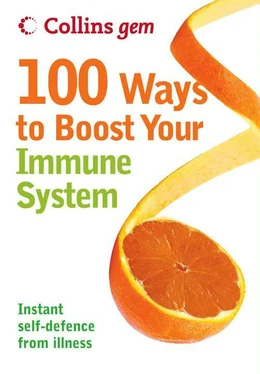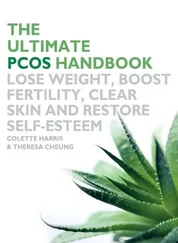100 Ways
to Boost Your
Immune System
Theresa Cheung
 Collins gem
Collins gem
Cover Page
Title Page 100 Ways to Boost Your Immune System Theresa Cheung Collins gem
INTRODUCTION INTRODUCTION YOUR INVISIBLE ARMY Without a strong immune system you can’t live younger or longer. Your immune system is your invisible army, working tirelessly around the clock to keep you fit and healthy, and fighting off invasion by foreign organisms that can lead to premature ageing and disease. A vigorous immune system is vital to good health, both physical and mental. Tiredness, frequent colds and other infections, allergies, mood swings and premature ageing are sure-fire signs of a weakened immune system. Learning how to protect and support your immune system is therefore the most important thing you can do for your health and well-being. Fortunately, there are many ways in which you can strengthen and support your immune system – and keep your troops in peak condition – without resorting to the use of antibiotics. This book gives you all the advice you need to achieve this healthy state of affairs. So be good to yourself. Read on to discover everything you need to know to stay free from disease and maximise your potential for high-level health, happiness and vitality. Drawing on a variety of disciplines in medicine and natural health, each immune booster in this book will provide practical strategies you can use in your daily life to strengthen your resistance to illness. And if you do get sick you’ll find information that will help you get well faster.
Part One: Understanding Your Immune System PART ONE: UNDERSTANDING YOUR IMMUNE SYSTEM
What is your immune system What is your immune system Your immune system is a complex interrelated network of organs, blood cells and chemical reactions that are your body’s basic – and mostly highly effective – defence mechanism against invasion from the hordes of bugs (bacteria, viruses, parasites and fungi) that are constantly trying to get inside you. Every day a healthy body with a fully functioning immune system sees off potentially dangerous organisms that can trigger illness, as well as protecting against quirks in your cellular system that might potentially develop into cancerous growths. If your immune defences are working at their optimum level of efficiency, your health is likely to be good. If, however, you feel under par or constantly unwell, this suggests that your immune system is compromised. Compromised immunity can leave you vulnerable to premature ageing and disease, and impair your ability to heal properly and live your life to the full. It’s no surprise that a recent study of healthy centenarians found they had one thing in common: a healthy immune system. A healthy immune system is therefore the key to good health and a long life.
Components of your immune system Components of your immune system The key components of your immune system are the thymus and the lymph system, together with the spleen, bone marrow, white blood cells and antibodies. The thymus is the source of T cells. T cells – a type of white blood cell or lymphocyte – are the foot-soldiers of your immune system. They destroy invaders that have been detected by B cells, another type of white blood cell. The lymph system transports nutrients to cells and filters waste. Lymph nodes are collections of lymphoid cells found throughout the body, including the neck, armpits and groin. They are connected by a network of lymph-carrying vessels and are the main sites of storage, activation and production of white blood cells. The spleen filters the blood, looking out for invaders, and also carries out regular ‘MOT checks’ on red blood cells. Bone marrow is the source of new red and white blood cells. White blood cells are actually a collection of cells that work together to destroy bacteria and viruses. There are numerous types of white blood cells: leukocytes, helper T cells, natural killer cells and so on. Finally, there are five primary types of antibody, known as ‘immunoglobins’, each of which responds and binds to a specific invader, preventing it from entering host cells. We need huge quantities of antibodies to protect us from the constant and daily bombardment of bacteria we unknowingly inhale or digest in our food.
How your immune system works How your immune system works Your immune system is an elaborate, interactive system of cells, chemicals and tissues located throughout your body. When any of its components come into contact with cells or substances – such as bacteria or viruses – to which they are programmed to respond, a series of reactions is triggered that destroys the invaders or renders them harmless. A cell or chemical that triggers an immune reaction is called an antigen, and that reaction can be either innate or adaptive. The innate immune response produces an immediate, nonspecific immune response to disease-causing antigens that enter or appear inside the body. An army of scavenging white blood cells constantly roams around your body on the lookout for bugs; if a white blood cell detects an ‘enemy’, then it is immediately transported to the nearest lymph node, situated in your neck, armpits and groin, and destroyed without mercy. You can feel this process happening every time your glands become swollen because innate immunity also includes the inflammation or swelling process. While the innate response is working on the front lines, the adaptive response system is quietly working behind the scenes to find a defence specifically tailored to deal with the antigen. Typically, the adaptive response takes about five to seven days to get completely mobilised; if the antigen works faster than that, you’re in trouble. Although the immune system is capable of diversifying its defence plan to meet a wide variety of invading antigens – and once immunity to a specific antigen has been developed that immunity will protect against future attacks by antigens that produce similar diseases – it’s important to point out that each antigen requires an individual response. So, if you’ve developed immunity to the chickenpox virus, you still need to develop immunity to deal with the measles virus and if you’ve developed immunity to one strain of flu virus you still need to develop immunity to deal with countless other cold and flu viruses.
Meet the bugs Meet the bugs Your body is under daily attack from infectious agents doing their best to get inside your body. To a bug, your body offers warmth, safety and food; these make it a very attractive proposition. Bacteria, viruses and other infectious agents live everywhere. You can find them in the air; on food, plants and animals; in soil and in water; and on almost every surface, including those of your own body. They range in size from microscopic single-cell organisms to parasitic worms that can grow to several centimetres in length. Most of these agents won’t make you ill, but others can cause infection and harm you. Even though your hard-working immune system is powerful and usually successful at defending you from invaders, it does face the constant threat of viruses and bacteria that are forever mutating, and seeking new ways to attack and break down your immune defences. Let’s take a look at the constant threats your immune system faces:
Signs of infection Signs of infection Diseases and infections are not the same thing. Infection is the first step to disease when bacteria, viruses or other antigens enter your body and try to multiply and take hold. Disease or illness occur when the cells in your body are damaged by infection, and signs and symptoms of illness will become evident. Common symptoms of infection, such as sweating, chills, fever, runny nose, sore throat, coughing and sneezing, are all indications that your immune system is doing its job and fighting back. In most cases the natural healing response your immune system offers is effective in warding off invading antigens but sometimes things don’t work so efficiently. Bacteria, a virus or other antigens make it past your immune defences and you get ill. And the most common way to get ill is with a cold or flu virus.
Читать дальше

 Collins gem
Collins gem


![Theresa Cheung - The Dream Dictionary from A to Z [Revised edition] - The Ultimate A–Z to Interpret the Secrets of Your Dreams](/books/692092/theresa-cheung-the-dream-dictionary-from-a-to-z-r-thumb.webp)







